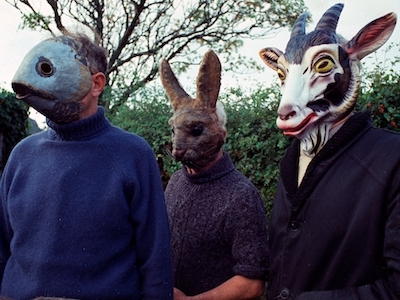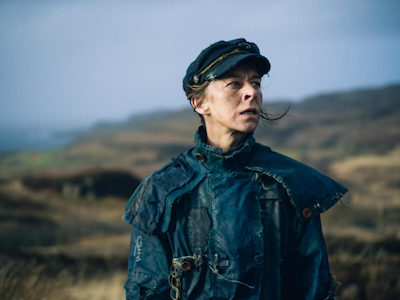by Peg Aloi

As a film genre, folk horror has only been identified in recent years, and has been gaining attention as independent filmmakers explore the aesthetics and themes that define this rich cinematic category. Though arguably the criteria for folk horror could be applied to any number of films of the past century, it was the experimental richness of the late 1960s that really established a tone and trajectory for the genre. The so-called “holy trinity” of Witchfinder General (1968), The Blood on Satan’s Claw (1971) and The Wicker Man (1973), all British horror films, are the standard bearers for the genre. A growing body of work has emerged from different countries, with some of the most well-known contemporary examples from filmmakers like Ari Aster (Hereditary and Midsommar, 2018 and 2019), and Robert Eggers (The Witch and The Lighthouse, 2015 and 2019), whose A24 releases were critical darlings, if not huge box office hits. Indeed, folk horror, though increasingly popular among horror aficionados, tends to find expression in the independent film niche. And though big studios are getting in on the trend (like Netflix, with The Ritual in 2017, Apostle in 2018 and In the Tall Grass in 2019), some of the most powerful folk horror films in recent years have been low budget indies. Some of these include Emma Tammi’s The Wind (2018), Rainer Sarnet’s Estonian film November (2017), Polish director Agnieszka Smoczyńska’s 2015 mermaid musical The Lure, and several films from British director Ben Wheatley including 2011’s Kill List, 2013’s A Field in England and 2021’s In the Earth.
One common element that all folk horror films share is the significance of landscape. The stories at the center of folk horror films are tied directly to the land: to its folklore, legends, ancestral peoples, spirits and history. One theme that recurs again and again is the idea of nature worship. The notion of animism (the presence of a soul in all inanimate objects and phenomena in nature) informs this belief system, and the paganism of pre-Christian Europe has left behind a rich tradition of folklore that is still very active, particularly in the British Isles. An important aspect of nature worship is the importance of propitiation: the practice of giving gifts or favors to the land (or the sea) to appease its gods or other entities. Hence, with The Wicker Man we see a contemporary society that still worships “the old gods” and offers up a human sacrifice to bless the crops. In The Blood on Satan’s Claw, we see a village of young people obsessed with reviving the old gods of the land and offering ritual sacrifices to that end.
And belief is central to the core of folk horror’s strength and complexity as a genre. Horror in general depends upon a suspension of disbelief, or on the presence of a character who is skeptical of the supernatural. Sometimes the question of belief is merely one of accepting the local version of history, passed down through oral tradition. The plot often turns on the swaying of skeptics to a position of belief or acceptance, when their ability to remain rational has been eroded by terror and fear, sometimes only moments before they meet an untimely demise. The portrayal of spirits, ghosts, monsters or other fearsome entities is sometimes ambiguous: is it real, or a figment of fear, or a product of suggestion?
Folk horror has been described in Woodlands Dark and Days Bewitched, the 2021 documentary by Kier-la Janisse, as the relationship between the prosaic and the uncanny. The point at which they meet is liminal, significant, and often a climactic moment in the arc of the story. The effect of place, or landscape, is a major component of this genre’s subtle terror. We see this in many contemporary folk horror offerings from both Europe and the US. Certainly, The Blair Witch Project (1999), a progenitor of more contemporary folk horror that began as a micro-budget indie that went supernova to become the highest grossing independent film of all time (at the time) suggests a haunting tied to the land. The witch rumored to have inspired people to commit murder in those woods many years ago seems to still be present, or, at least, the belief in her is strong enough that people commit gruesome acts in her name.

Location is central to the dramatic impact of Russell Owen’s film Shepherd, which premiered at this year’s London film festival. I had a fascinating conversation with Owen about this atmospheric folk horror film that was filmed on location in Scotland. It tells the story of Eric Black (Tom Hughes) who decides to escape from his life in order to grieve the recent death of his young wife. He accepts a job as a caretaker and shepherd on a remote island in northern Scotland. En route, he has two memorable encounters: one with his mother whom he’s not seen in many years (played with gravitas by Greta Scacchi) and one with the woman who ferries him from the mainland, played by Kate Dickie (The Witch). Owen shared his praise of these veteran actresses in two excellent performances, and that Dickie noticed the plot of the film was similar to The Lighthouse (both films are based on a Welsh legend). “I started writing this sixteen years ago and then Eggers’ film came out before I finished this project,” he said, laughing at the irony.
Owen knew location would be a crucial aspect of making this film, and originally wanted to film on Puffin Island in North Wales. It was a location dear and familiar to him, having grown up nearby and remembering the lighthouse shining through his bedroom window at night. “It’s a place with a very special quality and spirituality all its own, and a pagan history full of druid lore, with standing stones.” But the location proved to not be a practical choice: “Although I’d have loved to use it, it was too complicated to be able to film there,” he noted.
Owens described a long journey searching for somewhere suitable, driving from North Wales and along the west coast of England, finally to a Scottish estate on the island of Mull: “The location ends up being a character in the film, as much as the characters themselves, as much as sound becomes a character too.” Own explains how he wanted to have the island’s eerie silence define the location and went to great lengths to edit out birdsong that crept into the original sound recordings. This soundscape makes the place feel even more remote, something Eric felt he needed to process or escape his grief. He brings his dog but is otherwise alone with the sheep and the ghosts that haunt the lighthouse, the tiny cottage, and the very island itself. The lush cinematography by Richard Stoddard (who has worked extensively in British TV including Hinterland and Becoming Human) lends both stark beauty and suspense to this psychological tale. Shepherd is one of the most visually stunning folk horror films of 2021, and its carefully chosen location is haunting and unforgettable.
Peg Aloi is a member of the Boston Society of Film Critics, and was a long time freelance critic for the Boston Phoenix. She writes about film and TV regularly for the Arts Fuse, and other outlets including Time, Polygon, Vice, Refinery29 and the Orlando Weekly.
